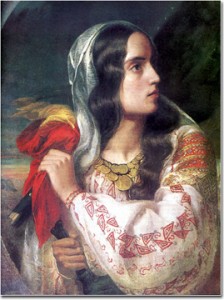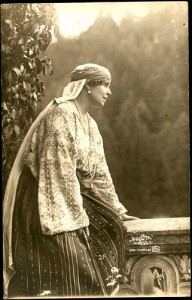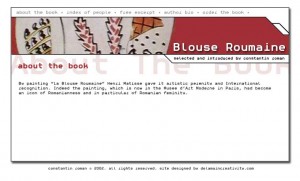 Blouse Roumaine – the Unsung Voices of Romanian Women
Blouse Roumaine – the Unsung Voices of Romanian Women
Review by Octavian Ciupitu, Curierul Romanesc, Sweden
(after the Romanian Text of September 2009)
The above title refers to an E-book collated and edited by Constantin ROMAN and published in English, in January 2009, by the Centre of Romanian Studies (London). This is an anthology of the lives and times of 160 women, born between 1805 and 1983, whose claim to fame is linked to Romania. In this first edition the book contains 1,047 pages, with black-and-white as well as colour illustrations.
Constantin Roman set out with a great deal of energy and enthusiasm in revealing the destinies of some extraordinary women who were either native-born or, as the case maybe, were closely linked to the Romanian scene. The philosophy of this book is to present, for the first time in English as a language of wide circulation, the universal value of some outstanding women, some of whom are little-known outside Romania, but also some women whose contrasting destinies gained a controversial reputation. To these are added the names of fifteen “Honorary Romanians”, by marriage or by vocation, mostly royals.
This “Hall of Fame” displays a tapestry of individual biographical essays interwoven with the destinies of world celebrities of living memory, an exercise meant to demonstrate the seminal contribution of Romanian culture, which unbeknown to many permeated a wide world stage.
This review refers to the 1st version of the 1st edition which has 1,047 pages divided in the following chapters:
- Acknowledgements
- Foreward by Catherine Durandin
- Preface – Matisse’s ‘Blouse Roumaine’
- Chapter 1 – Five Millennia of Romanian Women
- Chapter 2 – Gazetteers :
# Gazetteer of 160 women by date of birth (1805-1983)
# Gazetteer of 160 Women presented in 58 categories by Call, Profession or Social Status
- Chapter 3 Profiles in Alphabetical order from A to Z
- Chapter 4 Indexes
# Index of Names
# Index of Geographical Locations
# Index of Quotations
- Appendix Notes on Romanian and foreign spelling equivalents – surnames and nouns
The Foreword is signed by Catherine Durandin, Chevallier de la Légion d’Honeur, French Historian and Novelist, Professor of Romanian at the INALCO – the Institut National de Langues et Civilisations Orientales, Paris, author of several books on Romania, who was invested with the Order of the Grand Cross of Romania.
The Preface chapter, entitled “Matisse’s Blouse Roumaine” is an eighteen-pages long essay on the theme of the Romanian ethnic blouse (iia romaneasca) as it is painted in the corpus of Henri Matisses’s oeuvre and beyond. Constantin Roman uses the pretext of Matisse’s iconic painting to discuss in a broader context the Romanian cultural phenomenon embodied by a woman wearing the ethnic embroidered blouse, starting with the canvass of Daniel Rosenthal (1820-1851) the painter of “Revolutionary Romania” (1848), then presenting Nicoalae Grigorescu’s (1838-1907) “Girl from Muscel County” and moving on to Queen Marie of Romania (1875-1938) and Princess Ileana of Romania, Archduchess of Austria (1909-1991) both of them wearing the Romanian garb, as seen in a photograph of the 1920s and finally arriving at Matisse’s celebrated eponymous canvass “La Blouse Roumaine”(1940) now at the Musée d’Art Moderne in Paris and Pablo Picasso’s “Seated Woman with Book” (Norton Simon Museum, Passadena, California). Furthermore, the Preface presents two other themes entitled “A Romanian Blouse by Picasso?” and respectively “Post-WWII Romanian Women and the West”.
Chapter I: containing thirty two pages is most absorbing for its theme of “Five Millennia of Romanian Women” which in its turn is subdivided in five separate subjects: “Women of the Carpathian-Danubian Space – Five thousand years of Civilization”, followed by “Women of Myth and Legend”, “Women of Old – from Antiquity to the end of the XVIII century”, “Modern and Contemporary Women – XIX and XX centuries” and respectively “ The New face of Romania – XXI century”.
Chapter 2: has twenty four pages starting with a four-pages Timeline of Women by date of birth (1805-1983), beginning with the Revolutionary Ana Ipatescu (1805-1875) and finishing with the poet Ioana Alexandra Maris (b. 1983). This is followed by a nineteen-page Gazetteer of 160 Women within 58 distinct categories by Call, Profession or Social Status as follows: 22 Acadmics, 9 Actresses, 14 Anti-communist Fighters, 2 Architects, 9 Art Critics, 1 Book Binder, 6 Ballerinas, 20 Charity Workers, 2 Communist Politicians, 3 Courtesans, 2 Designers, 4 Diplomats, 11 Essay Writers, 6 Ethnographers, 87 Exiles or first-generation Romanians born abroad, 1 Explorer, 12 Feminists, 1 Folk Music Singer, 2 Gymnasts and Dressage Riders, 5 Historians, 15 Honorary Romanians, 3 Illustrators, 13 Journalists, 3 Librarians, 3 Linguists, 1 Literary Critic, 15 Mass Media Personalities, 5 Medical Doctors and Nurses, 1 Museographer, 1 Musical Instruments Makers, 24 Novelists, 15 Opera Singers, 14 Painters, 6 Peasant farmers, 4 Philosophers, 6 Pianists, 4 Pilots, 5 Playwrights, 29 poets, 30 Political Prisoners, 5 Politicians, 2 Revolutionaries. 34 Royals and Aristocrats, 8 Scientists, 4 Sculptors, 1 Slave, 20 Socialites and Hostesses, 51 Spouses and Relations of Public Figures, 2 Spies, 4 Tapestry Weavers, 25 Translators, 6 Unknown Illustrious, 4 Violinists, 3 Workers.
Given the aforesaid criteria, as each of the 160 women of this Anthology falls in several of the above categories, it stands to reason that the sum of all names in all categories put together are, understandably, well in excess of 160, more precisely they reach 577. To illustrate this point by giving a single example and searching for Silvia Constantinescu, the founder and promoter of the “Curierul Romanesc” Quarterly (Sweden) we find her name five times among the following categories of: “87 Exiles”, “13 Journalists”, “3 Librarians”, “15 Mass Media Personalities” and “25 Translators”, respectively.
Chapter 3: represents the main corpus of the Anthology containing 920 pages divided in sub-chapters each of these corresponding to a letter of the Alphabet. Each of the sub-chapters is preceded by a list of names, period and date of birth and death, followed by individual biographical essay for each woman. The structure of each entry observes an identical format: name, dates, category, portrait photograph, quotations, critical biographical essay, primary and secondary sources, URLs and iconography. In the case of artist painters an exhaustive list of exhibitions is given; for instrumentalists and singers there are selected lists of main performances as well as recordings available on CDs and DVDs, or/and the location of Opera houses and theatres where they had main performances, or début. For the reader who wishes to find out in greater detail about the biography or achievement of particular women these references are a treasure trove of over 4,000 entries.
Chapter 4: contains 45 pages with three Indexes as follows: 20 pages – Index of Surnames, 12 pages – Index of Geographical Place Names and respectively 13 pages – an Alphabetical Index of 605 Quatations from ‘Abortion’ to ‘Zip’ and from ‘Indoctrination’ to ‘Torture’.
The ADDENDUM: is intended to guide one through the confusing differences of the Romanian and the foreign spelling equivalents depending on the source language – Romanian, French, English, or German.
This wealth of information on women with a varied and complex personality offers a fascinating learning curve for those readers gifted with an intelligent and inquisitive mind, who may be particularly interested in a multidisciplinary approach of a social landscape projected against a European history stretching over two centuries.
As we follow the labyrinth of diverse destinies, depicted with fervour and consummate scholarship by the author, it is tempting to allow oneself to be spirited away in this ocean of of information, where each detail competes with each other for its intrinsic value and occasionally even for its sensational dimension. The quotations too make for an illuminating reading on a path of discovery: to give only two examples which are close to the spirit and philosophy of the Curierul Romanesc Quarterly:
The first quotation is an extract from the book “La Apa Vavilonului” (At Babel’s river), volume 2 (2001) by Monica Lovinescu (1923-2008), journalist, political analyst, radio broadcaster, anti-communist and Human Rights Activist exiled in Paris:
In Romania dissidence was an exception. Our resistance was present when it did not exist in the other satellite countries and it ended just as it started with our neighbouring countries. We fought and died in the Carpathian mountains, as the West was blind and deaf, basking in its victory and forgetting its hostages. From the prisons where our élite was destroyed in the 1960s emerged only the shadows of our earlier determination. Three successive waves of terror – 1948, 1952 and 1958 – had drained the collective organism. We caved into, a near-total silence. We sacrificed ourselves for nothing. With this sense of utter uselessness most of the survivors emerged from the jails, some of whom, while “free”, remained at the beck and call of the Securitate..
Finally, a second quotation is extracted from the interview of September 1997 which Stefan Racovitza, an exile in Switzerland had with Silvia Constantinescu, the founder and editor of Curierul Romanesc Quarterly (Sweden):
“Yourself”… “and some other exiled Romanians, you were alluding to the inability of Western intellectuals to accept/understand the horrors of Communism and furthermore you were also alluding to the dominant position of the Left-wingers in the West. Such was the case in Sweden. This attitude made light work for the Romanian embassies and for the Romanian Orthodox Church in Bucharest to denigrate those amongst the exiles who were politically active. The same was the case in Stockholm when it came to the campaign of denigration against the “Curierul Românesc” newspaper. This was carried out as much through Romanian communist channels as through their Swedish counterparts, which were extremely enthusiastic in this vein.”
The above two quotations of this Anthology were specially selected in order to prove that the idea of keeping alive the Memory of Romania’s Calvary under Communism represents an important theme of this book beyond the inevitable need of spicing the interest of the Anglo-Saxon readership with lighter interludes!
For this reason alone the idea of disseminating the Blouse Roumaine far and wide fills in an important gap – an exercise which is long overdue.
TRANSLATOR’S NOTE: The original Romanian text was published by architect Octavian Ciupitu in Curierul Romanesc, Sweden (see link below). Both the author and his wife Doamna Silvia Constantinescu founders of “Curierul Romanesc” allowed the translation of the above review to be published by the Centre for Romanian Studies (London). The illustrations and the reference to the Foreword by Catherine Durandin were further added to the English version by the Centre for Romanian Studies (London).
Source:
by kind permission.





No Comments so far ↓
Like gas stations in rural Texas after 10 pm, comments are closed.